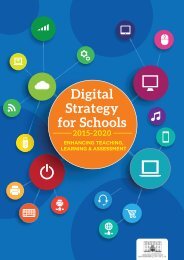K3zgZ
K3zgZ
K3zgZ
Create successful ePaper yourself
Turn your PDF publications into a flip-book with our unique Google optimized e-Paper software.
TRADOC Pam 525-8-2<br />
Figure 3-3. Learner-centric 2015 learning environment<br />
a. Context-based, collaborative, problem-centered instruction. Classroom learning will shift<br />
from instructor-centered, lecture-based methods to a learner-centered, experiential methodology.<br />
Engaging the learners in collaborative practical and problem solving exercises that are relevant<br />
to their work environment provides an opportunity to develop critical 21st century Soldier<br />
competencies such as initiative, critical thinking, teamwork, and accountability along with<br />
learning content. Students master knowledge and comprehension level learning objectives<br />
outside the classroom through individual learning activities such as reading, self-paced<br />
technology-delivered instruction, or research. Collaborative learning activities, discussion,<br />
identification of problems, and solving those problems is done in the small group classroom<br />
environment. This learner-centered instructional approach encourages student participation and<br />
puts the instructor in the role of a facilitator. Facilitators are responsible for enabling group<br />
discovery. Students and facilitators construct knowledge by sharing prior knowledge and<br />
experiences, and by examining what works and what does not work. The collaborative adult<br />
learning environment is nonthreatening; mistakes can be made as students weigh courses of<br />
action and as the facilitator guides the group to recognize better solutions.<br />
b. Blended learning. The term blended learning is defined most frequently as online or<br />
technology-delivered instruction combined with face-to-face instruction. It blends the<br />
efficiencies and effectiveness of self-paced, technology-delivered instruction 38 with the expert<br />
guidance of a facilitator, and can include the added social benefit of peer-to-peer interactions.<br />
(1) A 30 percent decrease in the time it takes to learn with no decrease in effectiveness is<br />
possible when educators develop technology-delivered instruction for appropriate learning<br />
content and design instruction according to established learning principles. 39 This instructional<br />
approach will be widely applied in the schoolhouse and replace most, if not all, instructor-<br />
19




